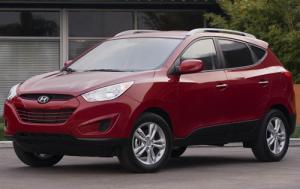- Save |
- Email |
- RSS |
- Newsletter

New Models
-
2011 Hyundai Tucson MSRP from $18,895
 View photos
View photos
Used Models
-
2010 Hyundai Tucson Used TMV from $17,596 Find Used Inventory
 View photos
View photos
-
2009 Hyundai Tucson Used TMV from $15,317 Find Used Inventory
 View photos
View photos
-
2008 Hyundai Tucson Used TMV from $13,211 Find Used Inventory
 View photos
View photos
-
2007 Hyundai Tucson Used TMV from $10,982 Find Used Inventory
 View photos
View photos
-
2006 Hyundai Tucson Used TMV from $9,520 Find Used Inventory
 View photos
View photos
-
2005 Hyundai Tucson Used TMV from $7,976 Find Used Inventory
 View photos
View photos
When the Hyundai Tucson debuted for the 2005 model year, it represented Hyundai's first entry in the long-established small SUV segment. Although the company's car-based Santa Fe sport-ute has often been grouped in this segment due to its budget price tag, it has always been midsize in its exterior dimensions. The first-generation Tucson became Hyundai's official "entry-level" SUV, and it offered a favorable combination of attributes, including an available V6 engine, a long list of standard equipment and a terrific warranty. However, this Tucson looked rather dowdy, had a decidedly low-budget feel to it inside and never really registered in people's minds as a mainstream option.
Enter the second-generation Tucson, which arrived for 2010 with sharp exterior styling and a slick interior to match. There's no V6 option, but the current four-cylinder is more powerful than the old-cylinder while being more efficient than the old base four. Overall, the current Tucson is a considerably more capable and interesting vehicle than before. A used first-generation Tucson isn't a bad idea if you're looking for no-frills transportation on a budget, but the second-generation Tucson takes Hyundai to a new level in this segment.
Current Hyundai Tucson
The five-passenger Hyundai Tucson is a car-based compact SUV. As such, it offers an elevated driving position, a flexible cargo area, predictable handling and respectable fuel economy. The Tucson is available in GL, GLS and Limited trim levels. The base GL comes standard with a 2.0-liter engine that produces 165 horsepower and 146 pound-feet of torque. It's paired to a five-speed manual transmission or an optional six-speed automatic. The GLS and Limited models get a 2.4-liter making 176 hp and 168 lb-ft of torque (slightly less for California-emissions states) with a six-speed automatic, and a choice of front- or all-wheel drive. The GL is front-drive only.
The GL comes standard with 17-inch wheels, hill-hold and hill-descent control, air-conditioning, full power accessories, a tilt steering wheel and a six-speaker audio system with iPod/USB interface. The GLS adds alloy wheels, roof rails, cruise control and Bluetooth, and all-wheel drive versions get heated front seats. Available options include a navigation system and rearview camera. The top-line Limited enhances offerings with 18-inch wheels, leather upholstery and an upgraded suspension, among other features.
In reviews, we've appreciated the Tucson's combination of style, sophistication and sharp road manners. The four-cylinder engine is peppy enough, and the Tucson's handling is European in character -- tight and composed, but with unfortunate impact harshness on rough pavement. Inside, there's plenty of room for four adults, and the contoured twin-cowl dash and available two-tone color schemes set the Tucson apart from competitors with plainer, trucklike interiors. Controls are simple and easy to reach, but maximum cargo capacity is down compared to competitors.
Overall, the Tucson is an appealing option that should be on any compact SUV shopper's short list, provided that V6 power and copious space are not required.
Used Hyundai Tucson Models
The current, second-generation Hyundai Tucson debuted for the 2010 model year. In that first year, the base GL trim level wasn't available.
The first-generation Tucson was produced from 2005-'09. In '05, Hyundai called the top-line model the LX rather than Limited, but from 2006 on there were three constant trim levels: GL, GLS and Limited. Other notable changes were limited to the 2008 addition of active head restraints, satellite radio and an auxiliary audio jack. Every first-generation Hyundai Tucson had antilock brakes, stability control, front seat-mounted side airbags and full-length side curtain airbags.
The base GL was powered by a 140-hp, 2.0-liter four-cylinder engine mated to either a five-speed manual (mandatory on AWD models) or a four-speed automatic transmission. Standard equipment included four-wheel disc brakes, alloy wheels and heated outside mirrors. The GLS had a 173-hp, 2.7-liter V6 and a four-speed automatic transmission as well as additional accoutrements. The top-shelf Limited model boasted items such as a sunroof, leather seats, automatic climate control and an upgraded audio system. As of 2009, a navigation system and a Kenwood audio system upgrade were optional.
In reviews, we praised the first-generation Tucson for its roomy interior and generous list of standard comfort and safety features. When the 60/40-split rear seat was folded flat, it opened up a respectable 65 cubic feet of cargo space -- more than the second-generation Tucson. On the downside, the four-cylinder simply didn't have enough power to move the Tucson with any authority, and the V6 was barely better than the four-cylinder engines found in some competing SUVs. Bland styling and inconsistent interior quality were also lowlights.
Research Models
Advertisement
New Car Resources
Advertisement
Advertisement
Recently Viewed